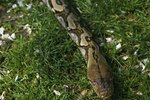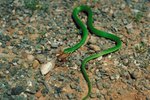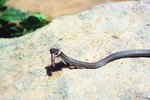
Native to Vietnam and China, the rhino rat snake (Rhynchophis boulengeri) is a unique-looking species best cared for by experienced or moderately experienced snake handlers. The rhino rat snake has a horn on his snout. Herpetologists don’t know the purpose the horn serves. As a hatchling, the snake has scales of a silver color; they turn green as the snake ages. The rhino rat snake grows to about 5 feet in length. In captivity, the species lives between 15 and 20 years with proper care.
Housing Requirements
You can keep rhino rat snakes in pairs. Because they are natural climbers, their enclosures need height. Adults need a vivarium at least 3 feet wide and 1.5 feet deep, with a height of 2 or more feet. They need Aspen or similar substrate, and plenty of branches for climbing and resting. Glass vivariums are best for maintaining the humidity level these snakes need, although plastic tubs can be used. Two covered hiding places, one at the cool end and one at the warm end of the enclosure, give them places to rest in seclusion. Rhino rat snakes also need a bowl of fresh water that is large enough for them to lay in to maintain moisture. The enclosure should be thoroughly cleaned and sanitized at least once per month.
Temperature and Humidity
In the wild, the rhino rat snake lives in humid tropical rainforests, so in captivity the snake has particular temperature and humidity requirements. Its enclosure should be maintained at 79 to 99 degrees Fahrenheit, with one side slightly cooler than the other to aid the snake's thermoregulation. Generally, you can accomplish this by using a UVB bulb during the day and a heat mat under the enclosure at night. The temperature can be controlled with a thermostat and monitored with a thermometer. Humidity at 75 percent is recommended, although the snake can handle drier environments as long as it has a humid, moss-covered hide box and a large water bowl. Proper humidity level can be maintained by lightly misting the sides of the enclosure once a day.
Feeding
Rodents make up the rhino rat snake diet in the wild and in captivity. Feeding your constrictors in a separate feeding enclosure prevents them from accidentally ingesting any of the substrate in its enclosure. If you keep a pair together, separate them from each other during feeding to avoid fighting. A rhino rat snake eats two large mice once every 10 days.
Handling and Temperament
Rhino rat snakes require attention and care in handling; their horns are fragile. These snakes are most active at dawn and dusk. They are calm snakes who rarely strike or bite. As a species, they are shy; females are particularly reclusive, while male rhino rat snakes like to bask in the open in the wild or on the branches of a captive enclosure. Your pair should be either a male and female breeding pair or two females. Males are territorial; if placed together in an enclosure, they will fight regardless of whether a female is present.
References
Photo Credits
-
Jupiterimages/Photos.com/Getty Images
Writer Bio
Jennifer Mueller began writing and editing professionally in 1995, when she became sports editor of her university's newspaper while also writing a bi-monthly general interest column for an independent tourist publication. Mueller holds a Bachelor of Arts in political science from the University of North Carolina at Asheville and a Juris Doctor from Indiana University Maurer School of Law.



